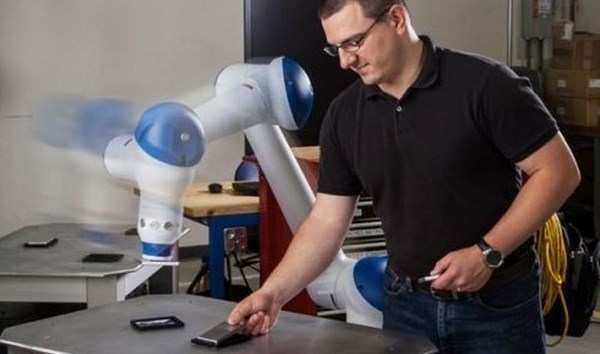Video: Cobot Considerations
Before investing in a collaborative robot, consider conducting a risk assessment to make sure the man and machine are matched to the application.
Learn more about human-robot collaboration in this video.
The benefits of incorporating a collaborative robot, or “cobot”—a robot specifically designed to operate safely in the presence of human workers—into your manufacturing environment are immediately apparent. First of all, they are very precise when handling parts, and they also don’t get tired toward the end of their shift—if there is, in fact, an end to their shift. This eliminates human error during operations such as checking part quality, where a weary worker might not examine the part as closely as a robot outfitted with a 2D camera. There is also the elimination of safety fencing, as cobots use sensors and “force-limiting” technology to sense the presence of human beings, first slowing down and then coming to a complete stop. This also occurs at the touch of a hand on the robot’s “skin,” which immediately ceases all movement. Programming has also been minimized on some models by the use of “hand guiding,” which allows a worker to move the cobot’s arm to each point in a job instead of typing in commands.
Still, prospective adopters of this technology should consider hiring a certified robotics expert to conduct a risk assessment to make sure that the robot, the application and the humans involved interact safely. That’s the best way to increase productivity in a truly safe manner, as this article suggests.
Learn more by visiting the Yaskawa America website and watching this video. Also, read "Cobots are Coming" on the subject from a past issue of Production Machining magazine.

Collaborative robots, or “cobots,” are designed to operate safely in the presence of human workers.
Related Content
-
The Advantages of Automated Shopfloor Gaging
This “parallel kinematic” gage offers the opportunity to automate and improve machining process control for shops endeavoring to move from sample inspection to 100% inspection.
-
Process Parsimony — Automation’s Secret Key for Scale and Quality
Automation is thought to be the secret to improving quality in manufacturing. What if I told you it was something else?
-
Automating Complete Workholding Changeovers for Turning
Robotic loading of all workholding elements is perhaps the next logical step to create fully automated yet flexible machining cells for CNC turning centers even when batch sizes are small.










